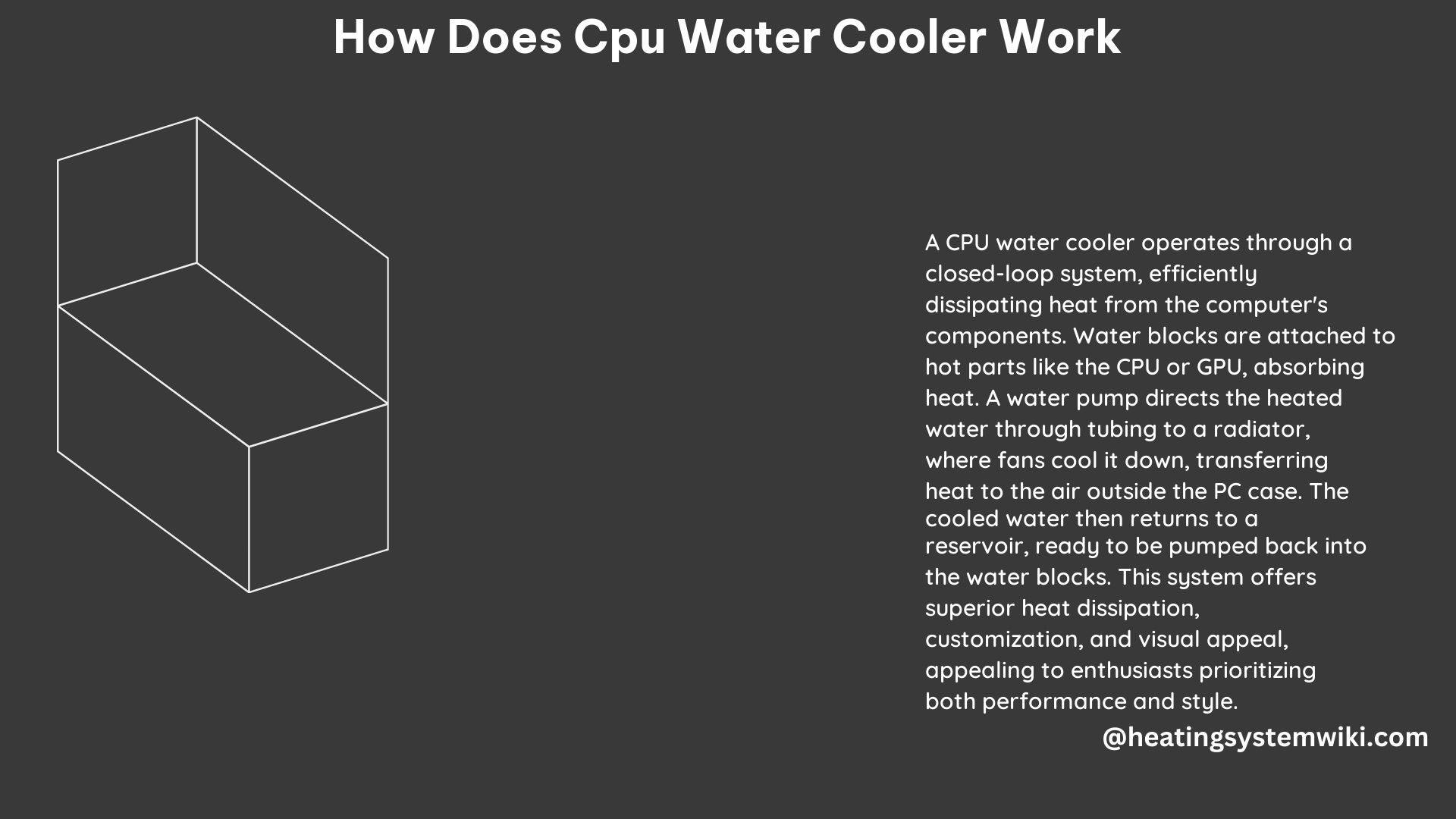A CPU water cooler, also known as a liquid cooling system, is a highly efficient and quiet cooling solution for high-performance computers. It works by transferring heat away from the CPU to a radiator where it is dissipated. The system consists of four key components: a pump, a reservoir, a water block, and a heat exchanger (radiator with a fan).
The Pump: The Heart of the Cooling System
The pump is the heart of the cooling system, circulating the liquid through all the components of the cooling loop. The pump should be chosen based on the size and thermal load of the system, with higher thermal loads requiring more powerful pumps. For example, a high-performance system with an overclocked CPU may require a pump capable of delivering a flow rate of 1 to 2 gallons per minute (GPM) to ensure efficient heat transfer.
The Reservoir: Holding Extra Coolant

The reservoir serves as a filling point for the coolant and holds extra liquid, which helps during the filling process. The reservoir should be chosen based on the size and layout of the case, with larger reservoirs providing more coolant capacity and easier filling. A typical reservoir size for a custom water cooling loop ranges from 120 to 360 milliliters (ml).
The Water Block: Increasing Surface Area
The water block, also known as a cold plate, is placed onto the CPU and uses dense microfins to increase the surface area where the coolant can interact with the block and pick up as much heat as possible. The water block should be chosen based on the size and thermal load of the CPU, with higher thermal loads requiring larger and more efficient water blocks. A high-performance water block can have a surface area of up to 25 square centimeters (cm²) and a thermal resistance as low as 0.05°C/W.
The Radiator: Dissipating Thermal Energy
The radiator is a heat exchanger used to transfer thermal energy from one medium to another. It consists of small tubes and densely packed fins, which cool the coolant as it flows through the radiator. The radiator should be chosen based on the size and layout of the case, with larger radiators providing more surface area and better cooling performance. A high-performance radiator can have a surface area of up to 1,800 cm² and a thermal resistance as low as 0.03°C/W.
The Fan: Increasing Cooling Efficiency
The fan is added to force air to the radiator, further increasing the efficiency of cooling and reducing noise levels. The fan should be chosen based on the size and thermal load of the system, with higher thermal loads requiring more powerful fans. A high-performance fan can deliver up to 200 cubic feet per minute (CFM) of airflow and produce noise levels as low as 20 decibels (dB).
Tubing and Fittings: Interconnecting the Components
The tubing and fittings interconnect all the key components and should be chosen based on the size and layout of the case, with larger tubing providing better flow rates and easier installation. A typical custom water cooling loop uses 10 to 13 millimeter (mm) diameter tubing and high-quality compression fittings to ensure a secure and leak-free connection.
Coolant: Choosing the Right Fluid
The coolant should be chosen based on the thermal and chemical properties, with non-conductive and non-corrosive liquids being the best choice for longevity and compatibility. A high-performance coolant can have a thermal conductivity of up to 0.6 W/m·K and a specific heat capacity of up to 3.6 kJ/kg·K.
DIY Guide: Building a Custom Water Cooling Loop
Building a custom water cooling loop requires careful planning and attention to detail. Here are the general steps for building a custom water cooling loop:
- Choose the components based on the size and thermal load of the system.
- Plan the layout of the loop, minimizing the distance between the components and the radiator.
- Install the pump, reservoir, and water block onto the CPU and case.
- Route the tubing carefully, avoiding kinks and bends.
- Fill the loop with coolant, checking for leaks and bubbles.
- Test the system, monitoring temperatures and noise levels.
- Maintain the system regularly, checking for leaks and buildup.
By following these steps and using the right components, you can build a custom water cooling loop that provides optimal cooling performance and a unique aesthetic to your PC build.
References:
– https://www.youtube.com/watch?v=6knc_2vV1wE
– https://www.youtube.com/watch?v=y1gCWh-Km1U
– https://www.reddit.com/r/buildapc/comments/j9nm3/could_someone_explain_exactly_how_liquid_cooling/
– https://www.ekwb.com/custom-loop-configurator/
– https://www.ekwb.com/resources/
– https://www.crucial.com/articles/pc-builders/water-cooling-vs-air-cooling
– https://computer.howstuffworks.com/liquid-cooled-pc.htm
